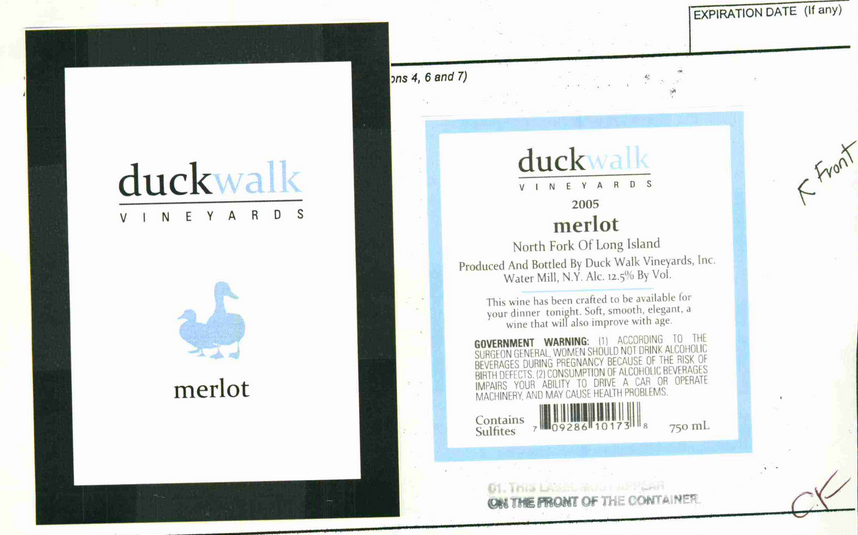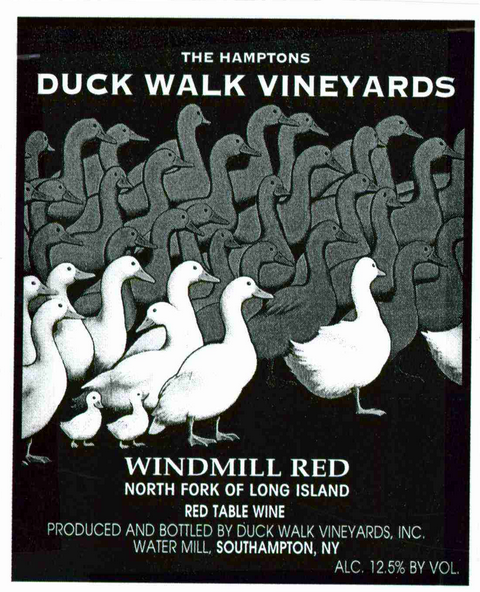Last year, California-based Duckhorn Wine Co. filed a complaint against Long Island-based Duck Walk Vineyards alleging consumer confusion and breach of settlement agreement that resolved a prior trademark infringement action between the two parties. See Duckhorn Wine Co. Files a Complaint Against Duck Walk Vineyards Alleging Consumer Confusion on Wine Labels; see also Duckhorn Asks N.Y. Winery to Modify Labels and Sales. One of Duckhorn’s lawyers stated that Duck Walk Vineyards did not follow a 2003 settlement agreement in which Duck Walk agreed to several constraints—including placing the vineyard’s place of origin on the front label of Duck Walk wines containing duck images, as well as restrictions to production volume and geographic distribution of Duck Walk wines with duck images—the alleged breach of which was the foundation of Duckhorn’s complaint.
This past week, the United States District Court of Eastern District of New York denied Duck Walk’s motion to dismiss. See Duckhorn Wine Co. vs. Duck Walk Vineyards, Inc., 13-CV-1642. Duck Walk had moved to dismiss the original compliant for failure to state a claim upon which relief can be granted pursuant to Federal Rule of Civil Procedure 12(b)(6). In its complaint, Duckhorn alleged that Duck Walk had breached the settlement agreement between the two parties by:
- Failing to include the geographic location or place of origin (referred to as “Prefatory Language” in the Agreement) on the true front labels of Duck Walk’s cabernet sauvignon, merlot, and brut sparkling wines;
- Using duck images on its labels that were not approved or similar to those approved for use by the parties’ Settlement Agreement (i.e., use of two blue ducks in a silhouette is not similar to any of the approved images by Duckhorn, which generally contain about nine white ducks); and
- Selling Duck Walk wines in excess of agreed upon production and distribution limitations (i.e., selling more than 50% of Duck Walk’s annual Gross Production outside of New York, New Jersey, and Connecticut of wines containing the word “Duck” and/or the image or picture of ducks with the exception of Duck Walk’s corporate name, Duck Walk Vineyards, Inc.).
(One of the labels which Duckhorn opposed features blue duck silhouettes and is pictured at below. Duckhorn alleged that the label pictured on the left-hand side is the actual front label of the wine—not the label containing the Government Warning Statement, vintage year, origin, and producer’s name and address—and, as such, the actual front label fails to contain the requisite Prefatory Language of the Settlement Agreement. Duck Walk, however, argued that the front label is the label pictured on the right-hand side, the very same label that TTB recognizes as the wine’s “front” label under requirements outlined in 27 CFR Part 4.)
It its motion to dismiss, Duck Walk argued:
- The Certificate of Label Approvals (“COLAs”), including that for its cabernet sauvignon, brut, and merlot, demonstrate that Duck Walk did comply with the Prefatory Language;
- The blue duck silhouette image does not violate the Settlement Agreement because the Agreement does not specifically restrict the color or amount of ducks; Duck Walk simply reduced the number of ducks and made them blue in color; and the duck is the same or similar type to those ducks approved in the Settlement Agreement; and
- Duck Walk has not sold more than 50% of its annual Gross Production outside of New York, New Jersey, and Connecticut.
In its motion to dismiss, Duck Walk interestingly argued that the Settlement Agreement made Duck Walk’s compliance “expressly contingent upon approval of the BATF [TTB].” Id. at 9 (quoting Duck Walk’s motion). Meaning, if the TTB approved of a label as the “front” label, such label would be considered the “front” label of the wine in the context of the Settlement Agreement. The vineyard furthered its argument for compliance by stating that TTB considered the front label of the wine at issue to be the label containing the “alcohol percentage, government warnings, and product bar code.” Id. The District Court found Duck Walk’s first argument to be “patently meritless.” Id. at 10. In interpreting the parties’ Settlement Agreement, the Court found that Duck Walk could not merely comply with the Agreement’s requirement by obtaining label approval from TTB. Further, the Court noted that if it accepted Duck Walk’s argument, then a “front” label with the Prefatory Language could be placed anywhere on the wine bottle as long as such was approved by TTB (i.e., on the neck, strip, etc.)—and this could not possibly be what the parties intended.
The Court also rejected Duck Walk’s argument about the blue silhouette ducks and stated the vineyard’s argument was “absurd” and the words of the Settlement Agreement “permits Duck Walk to use only one of the approved images . . . or ‘such similar pictures or depictions.'” Id. at 13 (quoting the Settlement Agreement). After analyzing Duck Walk’s blue duck silhouette in comparison to one of the labels annexed in the Settlement Agreement, the Court concluded that “the only thing similar about these images is that they contain ducks.” Id. at 14. (See example label below indicating one of the styles of ducks approved in the Settlement Agreement.)
With respect to the production and distribution restriction claim, Duck Walk provided a declaration from its CEO, which introduced allegations and documents outside of the Complaints. However, the Court noted that, pursuant to FRCP 12(b)(6), a court’s review is limited to the facts asserted within the “‘four corners of the complaint, documents attached to the complaint as exhibits, and any documents incorporated in the complaint by reference'” and thus could not consider such facts without converting the motion to dismiss into a motion for summary judgment (which the Court deemed inappropriate given the factual dispute and the absence of discovery or evidentiary hearing). Id. at 15 (quoting McCarthy v. Dun & Bradstreet Corp., 482 F.3d 184, 191 (2d Cir. 2007)).
Images property of the Alcohol Tobacco Tax and Trade Bureau.
For more information on wine or alcohol law, labeling, or trademark, please contact Lindsey Zahn.
DISCLAIMER: This blog post is for general information purposes only, is not intended to constitute legal advice, and no attorney-client relationship results. Please consult your own attorney for legal advice.
al advice.


Wine & civil procedure. Love it!
Hi Lindsey,
I really enjoyed this article and your previous one re this case. I am a trademark attorney who works with small wineries and others in the alcohol beverage space and I share your fascination with these issues. I just reposted your article to our social media sites.
Two quick comments re your Feb. 2013 article re this case:
First, you mention that more than 400 COLAs have been approved since 2007 that contain the term “Duck.” But just because a COLA is listed as approved does not mean there is wine being sold bearing that label. The TTB’s mechanism for surrendering a COLA is voluntary and many COLAs stay listed as approved in TTB records even though no wine is being sold under that label.
Second, you mention that the term “Duck” is generic. As you probably know, the issue of genericism in trademark law is contextual. While the term “duck” may be generic in connection with duck-related products and services like pate or hunting, it is certainly not generic as used with wines!
Please feel free to contact me directly at my work email if you’d like to continue this dialog and regardless, thanks for the great blog. I’m looking forward to reading your “Minimalist Label” article next!
All the best,
Liz
Hi Liz,
Thanks so much for your comments. Great to meet you. I wasn’t suggesting that just because there were label approvals for other wines containing “Duck” as the brand or fanciful name that such labels were used in commerce; I do understand that just because a label is approved by the TTB does not mean that the label is actually sold using that label or that name. I also realize that there may be other labels approved by TTB (and used in commerce) that may not have come up as results in my quick search of the COLA database as perhaps “Duck” was not used in the brand name or fanciful name of the actual label application. But I apologize if the article I wrote seems to suggest that approval designates use in commerce; I do understand that is not the case, and I was simply making an observation that there are other companies that have approvals using the term “Duck.”
very interesting article. IMHO, those at Duckwalk would find time better spent on improving their wines rather than ill fated lawsuits. Or was this all a way to increase name recognition? Invest in your winery, not your lawyers.
Hi Dillon,
Thanks for your comment. I don’t think that Duck Walk was trying to increase its recognition or gain attention, as they were not the party who actually initiated the lawsuit. This entry details Duck Walk’s motion to dismiss a complaint originally filed by Duckhorn. So, Duck Walk did need to respond and hire lawyers, otherwise they may have risked defaulting.